Mark Caney's Blog, page 4
June 1, 2020
Audiobook Tour Coming Soon
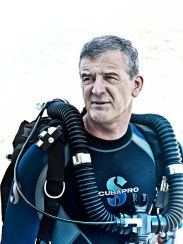
Hi, this is Mark Caney. For one week starting on June 28, I will be doing an Audiobook Tour to discuss the newly released audiobook version of my novel, Dolphin Way. During the tour, there will be a series of online sessions in which I’ll chat with the hosts of different book blogs that review audiobooks. I’ll post more details later, but if you’d like an idea of what the book is about, watch the 90-second interview here:

May 26, 2020
Dolphins’ ancestors evolved pebble-shaped teeth to crush shellfish
As bad as things might seem here in 2020, they could be worse: we could be living 252 million years ago during the Permian mass extinction. Volcanic eruptions and dramatic, sudden climate change killed most of the animals on land and almost everything in the oceans, setting the stage for the later rise of the dinosaurs on land and an explosion of new marine life. One kind of marine reptile, the ichthyosaurs, eventually evolved into sleek, dolphin-like predators, but scientists don’t know much about early ichthyosaurs. But by CT-scanning the fossil of one of the first ichthyosaurs, scientists discovered pebble-shaped teeth hidden in its short snout. These strange teeth, probably used for crushing the shells of snails and clam-like bivalves, help illuminate the ways that early ichthyosaurs filled different roles in Triassic marine ecosystems.
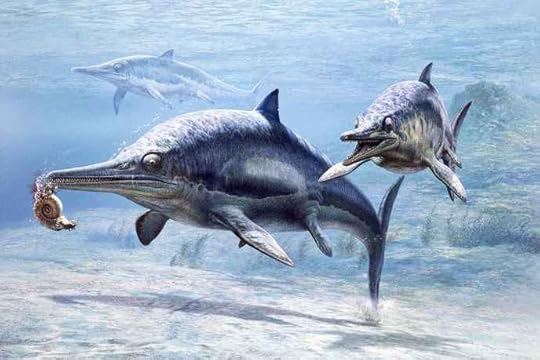
“We don’t know exactly the ancestry of ichthyosaurs. They’re reptiles, and they’re probably archosaurs — that is to say, they’re more closely related to crocodiles and dinosaurs and birds than they are to lizards and snakes — but even that isn’t 100%,” says Olivier Rieppel, a paleontologist and Rowe Family Curator of Evolutionary Biology at Chicago’s Field Museum, who co-authored a new paper on the findings in Scientific Reports. “By studying this early ichthyosaur’s unusual rounded teeth, we get a better understanding of how these animals evolved and what their lifestyles were like.”
The paper focuses on Cartorhynchus lenticarpus, one of the earliest and smallest ichthyosaurs ever discovered. Later ichthyosaurs were dolphin-like, with long snouts full of sharp teeth and sleek, streamlined bodies for cutting through the water. But if those ichthyosaurs looked like murder dolphins, then Cartorhynchus was kind of a seal-tadpole. Its name means “short-snouted,” and its face matches its name. Cartorhynchus was only a little more than a foot long, and its flexible wrist joints suggest that it was able to come up out of the water and scoot around on land like a seal. “Ichthyosaurs became creatures of the open ocean, but the smaller species like Cartorhynchus probably lived closer to the shore and picked up invertebrates to eat from the sea floor,” says Rieppel.
This new study builds on the description of Cartorhynchus by several of the same scientists in 2014, including the new paper’s corresponding author, Ryosuke Motani of the University of California, Davis. “When we first described Cartorhynchus, we thought that it didn’t have any teeth at all and was a suction feeder. But later on, researchers realized that it did have some teeth further back in its jaws,” says Rieppel. “In this study, we took CT scans of the fossil to see the teeth that were hidden in its skull, and we found that they had an unusual pebble-like shape.”
These rounded teeth were in the back of the jaws, where our molars are, and were likely used to crush small hard-shelled invertebrates like snails and clam-like bivalves. The teeth also showed wear and tear suggesting that even though the only known specimen of Cartorhynchus was just over one foot long, it was full-grown.
Armed with this new knowledge about Cartorhynchus, the researchers compared it to other early ichthyosaurs. They found that rounded teeth cropped up in several other ichthyosaur species, suggesting that the trait evolved independently more than once, rather than all round-toothed ichthyosaurs evolving from one common round-toothed ancestor. Meanwhile, many other early ichthyosaurs had pointed cone-shaped teeth.
These different tooth shapes springing up in different families gives us a glimpse of the world in which ichthyosaurs were evolving. “There were no marine reptiles prior to the Triassic,” says Rieppel. “That’s what makes these early ichthyosaurs so interesting — they tell us about the recovery from the mass extinction, because they entered the sea only after it.” And, since most sea creatures died in the mass extinction, there was a lot of free real estate, evolutionarily speaking — lots of niches for new animals to fill. “After the mass extinction, the marine biota was nearly empty and ready to be recolonized,” Rieppel explains.
Animals’ teeth can tell us a lot about their lifestyles: what they were eating and how. The rapid emergence of lots of different kinds of ichthyosaurs with different kinds of teeth points to the way that they took over the oceans and played different ecological roles. It’s also likely that the repeated evolution of rounded crushing teeth in ichthyosaurs like Cartorhynchus and others was driven by the evolution of hard-shelled prey that became prevalent at this time.
Full story: Science Daily

May 22, 2020
Dolphins often seem to want to befriend us
You’ll have heard of Fungie, a male bottlenose who has forsaken the open sea to live inside the harbour mouth of Dingle in Ireland, a placid, shallowish inlet bordered by low verdant hills that are speckled with sheep.
According to local legend, he has been swimming around in this area, not much bigger than a few city blocks, since October 1983.
It doesn’t seem like an auspicious place for a dolphin to settle. Though the bay is sheltered from snarlier North Atlantic conditions – churning seas, huffing winds – dolphins are well equipped for these things and seem to revel in the action: surfing down the faces of waves, leaping through the wakes of ships, playing in the maelstrom. By comparison, the Dingle harbour is a pond. Nor could it be mistaken for a marine sanctuary: it was known in the past for its abundant reservoirs of rubbish. So what was a full-grown bottlenose with an entire ocean at his disposal doing in this fish tank? And where was his pod? Being part of a pod means protection, hunting success, society, sex, kin – the fundamentals of dolphin existence. A solitary dolphin is like a floating oxymoron. So how did this one survive?
The tales of Fungie the loner dolphin seem improbable. But surprisingly, there are others like him. Scientists don’t know why it happens, but tales of dolphins befriending humans reach far back into history. Aristotle wrote offhandedly about dolphins’ “passionate attachment to boys”, as if everyone just knew this as a fact. In the year AD 77, Pliny the Elder recounted the story of a dolphin named Simo who formed a bond with a boy who fed him bits of bread, giving him rides in return:
“This happened for several years, until the boy happened to fall ill of some malady and died. The dolphin, however, still came to the spot as usual, with a sorrowful air and manifesting every sign of deep affliction, until at last, a thing of which no one felt the slightest doubt, he died purely of sorrow and regret.”
When you consider how risky it is for dolphins to spend time in close proximity to people, it is all the more intriguing that so many human-dolphin stories have similar themes: dolphin seeks out man, dolphin wants to play with man, dolphin assists man, dolphin rescues man. If dolphins didn’t already have such a well-established reputation for showing up like Superman in the third act, it would be impossible to put their behaviour into context. But there are centuries and even millennia of tales of their generosity towards the awkward two-legged creatures they encounter who are so out of their element.
In the book Beautiful Minds, biologist Maddalena Bearzi recalls tailing a pod of bottlenoses on one grim, foggy morning along the coast of Los Angeles, as they herded a huge school of sardines. If there’s anything that commands a dolphin’s attention it is a mother lode of fish, so Bearzi was surprised when one suddenly broke away from feeding and headed out to sea at top speed. The rest of the pod followed; so did Bearzi and her crew. The dolphins arrowed about three miles offshore and then they stopped, arranging themselves in a circle. In the centre, the scientists were shocked to see a girl’s body floating.
Tales like this are remarkably common and surfers, in particular, seem to benefit from dolphin intervention. When Todd Endris was bitten three times by a great white shark near Monterey, California, dolphins drove off the marauder, formed a ring around Endris, and escorted him to the beach. Australian Dave Rastovich, straddling his board waiting for a wave, was astonished to watch a dolphin hurtle itself at a shark that was torpedoing towards him, sending it fleeing.
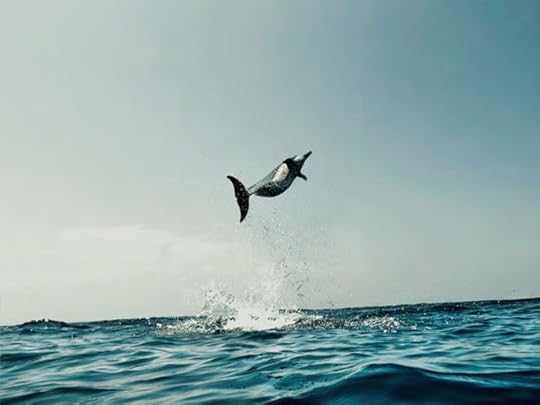
Full story: Independent

May 21, 2020
Shedding Genes Helped Whales and Dolphins Evolve for Life at Sea
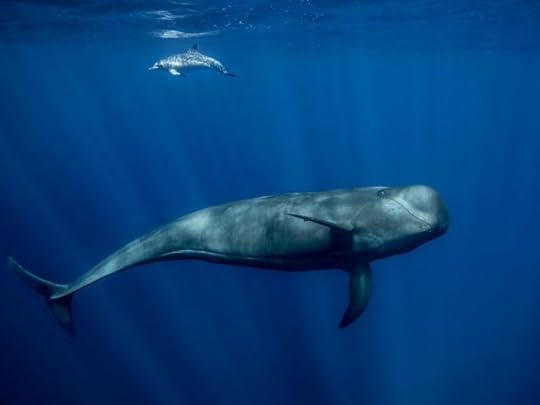
About 50 million years ago, ancestors of the modern whale transitioned from land to sea, undergoing remarkable transformations in the process. They gained collapsible lungs, thick layers of blubber and blood that stores more oxygen. But they also shed many traits that were critical for terrestrial life, such as genes involved with sleep, blood clotting and DNA repair, a new study published in the journal Science Advances suggests.
Researchers compared the active genes found in modern cetaceans, which include whales, dolphins and porpoises, with those of other mammals such as their closest living relatives, the hippo family. They identified 85 genes that became inactive when cetaceans became fully aquatic, 62 of which had not been reported before, reports Veronique Greenwood at the New York Times.
Previous studies found that the genes that enabled hair growth, sweat and hind limbs had been lost in cetaceans. But the new findings go even further to describe the genetic reasons behind such major physiological, behavioral and anatomical changes.
“There have been a lot of studies like this, but this has probably been the most comprehensive in terms of the number of genes,” Michael McGowen, research scientist and curator of marine mammals at Smithsonian Institution’s National Museum of Natural History, who was not involved in the study, tells Smithsonian magazine.
Some of the inactive genes that Hiller and his team identified simply became obsolete in a marine environment. These “neutral losses” include a gene that produces saliva. Other losses seem to be driven by the necessity of adapting to a new aquatic lifestyle.
Blood clotting, for example, may seem like an advantageous mechanism in mammals. Yet, when cetaceans dive, their blood vessels constrict and nitrogen bubbles make the blood clot more easily, restricting the flow of much-needed oxygen in the bloodstream. Ridding the body of clotting genes makes diving less dangerous.
Though they are air-breathing mammals, whales and dolphins often go for long periods of time without taking in fresh oxygen. This behavior can cause DNA damage that may result in the formation of tumors and other maladies. The enzyme that repairs this type of DNA can be faulty enough to cause serious harm. Because cetaceans undergo frequent DNA damage, researchers suspect that this enzyme was eventually ditched in favor of less harmful restorative enzymes.
“We think that by losing the sloppiest protein involved, you probably increase the fidelity of DNA repair,” Hiller tells Tina Hesman Saey at Science News.
Additionally, modern cetaceans are missing four genes related to the production of melatonin, a sleep hormone. Unlike most aquatic creatures, at least half of a cetacean’s brain is alert at all times to signal when to surface for a breath of air. Melatonin can put the body into a deeper restive state, which is dangerous for whales and dolphins who can sink or drown during long stretches of inactivity.
While evolutionary scientists commonly accept that underutilized genes tend to disappear or become inactive during the evolutionary process, this study suggests that genes potentially dangerous to a new lifestyle can also be abandoned or become non-functional.
Read full story: Smithsonian

May 17, 2020
New Kindle version available
The Dolphin Way Kindle version has just been updated to correct a few minor typos in the first edition. If you previously bought a copy, you should be able to get the latest version of the book quite easily. Any future purchases will be the updated version, and if you have not got it already, you can get it from here:
Get Kindle version
All you have to do to update a previously purchased version is to go to the Manage Your Kindle item on your usual Amazon web page menu, click where it says “hello your name – Your Account” and then Manage Your Kindle. You then click the “update available” next to any book that has an update. Then click the Update this title now link, as in this image.

You’ll be shown a confirmation that explains about the annotations, as if you have made notes in your copy of Dolphin Way, you will lose them. If you don’t, click Update. That’s it!

May 14, 2020
Watch this baby free dive with wild dolphins
A two and a half year-old baby having an amazing experience with its mother in the Red Sea.

May 9, 2020
DOLPHINS CALL EACH OTHER BY UNIQUE ‘NAMES’
Bottlenose dolphins are all individuals. Each one communicates with a unique whistle and researchers are now tuning in to these distinct noises to help protect the much-loved species.
Scientists at Edith Cowan University (ECU) and Curtin University in Australia are using sound, instead of sight, to track dolphin communities. As part of the study, bottlenose dolphins living in Western Australia’s Swan River were monitored to find out if unique whistles could be attributed to individuals. It was the first time attempted acoustic tracking was trialled in the area and by the time they had finished, over 500 whistles had been matched to dolphin photos.
Curtin University Professor Christine Erbe tells Euronews Living, “a whistle is like a name for an individual.” Each individual dolphin “has a unique signature whistle which it emits when it is isolated from the group, so that animals can find each other again. These are like contact calls.”
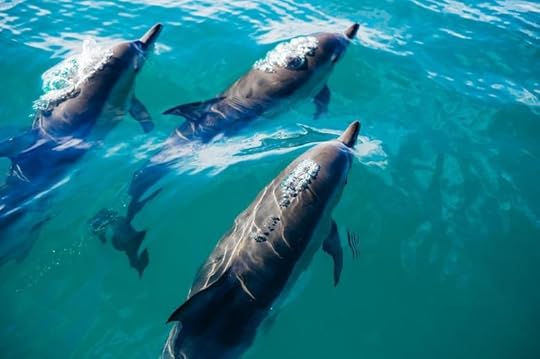 School of dolphins swimming side by sideUnsplash
School of dolphins swimming side by sideUnsplashThese results could have significant implications for dolphin conservation globally, ECU researcher Associate Professor Chandra Salgado confirmed. Until now, researchers around the world have relied on “laborious and expensive visual surveys on boats to track individual dolphins,” she says.
The study was based on data from previous research trips in recent years. Results were obtained by matching the recycled data from two independent studies, one on photo-ID, the other on underwater sound, to see the correlation. “We literally went through our databases to find days when we had simultaneous photographs of dolphins and underwater recordings,” says Christine. “Our next goal will be to narrow this down to individuals.
Read full story:

May 4, 2020
Wild Dolphins Seem to Have a Range of Personalities
If approached by someone decked out in snorkeling gear, would you say hello, or just avoid them? That’s one situation that behavior ecologist Bruno Díaz López posed to bottlenose dolphins in Italy’s Gulf of Aranci.
Using photoidentification surveys, Díaz López studied 24 dolphins between 2004 and 2011. The dolphins were introduced to something unusual—either a scuba diver or a shrill noisemaker—and Díaz López found that each had a consistent reaction over time. Some are bold, quick to approach the person or noisemaker, and others are shy, giving the threatening intruder a wide berth. Some dolphins fell somewhere in the middle.
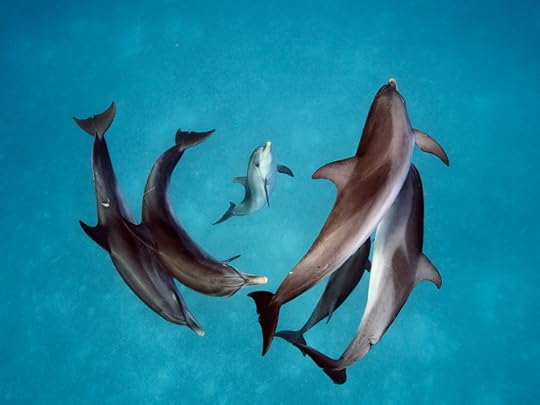
“We’d known that dolphins have these personalities from captive studies, but that is not their normal lives,” Díaz López, also the director of the Bottlenose Dolphin Research Institute in Pontevedra, Spain, tells National Geographic’s Virginia Morell. “Now, we know wild dolphins have personalities, and that these are important in their social system—as they are in ours.”
The new research, published in the journal Animal Behavior, adds to an ever-growing body of knowledge about dolphin behavior. The cetaceans live in social groups that vary in size and often change over time as animals leave or join in, making them “fission-fusion” groups.
Research has shown that dolphins’ social groups are incredibly complex, and in some ways, similar to ours. Earlier this month, a study showed that pairs of males travel together and sing in sync to attract mates. Other research provided evidence that dolphins call each other by name and grieve their dead.
In 2018, researchers with the Morigenos-Slovenian Mammal Society found that groups of dolphins near the coast of Slovenia found a way to avoid each other but share a favorite feeding area every day. In that study, each of the two groups of dolphins had core “cliques” that were only seen together four times in 16 years, Atlas Obscura’s Anna Kusmer reported. Animals outside of the core clique were “tiered” by how often they interacted with the core group, ending with lonely stragglers that weren’t bonded to either group specifically.
The new dolphin personality study looks at each dolphin individually to understand how its personality affects the group dynamic—Díaz López even mapped out the dolphins’ relationships in the 24-animal group. Males and females were bold and shy in similar amounts. Bold dolphins seemed to play favorites, showing a preference for certain companions. And Díaz López tells National Geographic that because bold dolphins enjoy the company of others, they may be the ones spreading information in the group, too.
“The study should be applauded for demonstrating these expected links in real life, where getting the data is super-challenging,” Tel Aviv University behavioral ecologist Orr Spiegel, who wasn’t involved with the study, tells National Geographic.
But the study does not address a pressing concern: the evolutionary benefit of personalities in dolphins, as University of Exeter behavioral ecologist Sasha Dall tells National Geographic.
The noisemaker that Díaz López used in the study is intended to keep dolphins away from fishing nets to prevent them from taking the catch from fishermen, and stop them from getting caught in the net themselves. But as Díaz López told Faro de Vigo’s Manuel Mendez, the devices may do more harm than good, not only introducing noise pollution to the area but also inadvertently training the dolphins to think of it as a dinner bell.
And once a bold dolphin figures that out, it might tell all of its friends.
Source: Smithsonian

April 11, 2020
Dolphin Way coming on Audible
As I have some extra time on my hands while self-isolating, I have built myself a temporary recording studio and I’m now recording an Audible version of my book, Dolphin Way. It’s a slow process, but I’m very pleased with how it’s coming together. I think it should be available in about a month from now. – Mark Caney


February 23, 2020
Latest thinking on how whales and dolphins evolved for life at sea
A new study shows that the genomes of cetaceans, which include dolphins and whales, have changed in important ways to allow these animals to transition from terrestrial to aquatic environments.
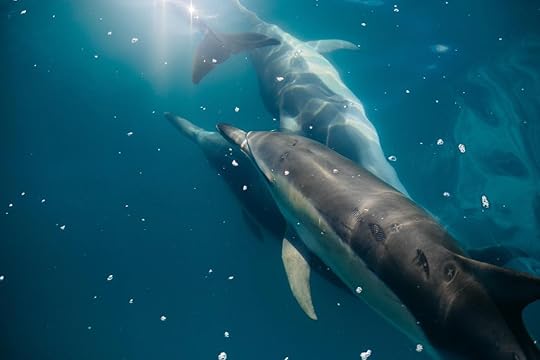
Although cetaceans, such as dolphins and whales, look like fish and — just like fish — live in aquatic environments, they are, in fact, aquatic mammals.
Therefore, they are, in many ways, closer to land-dwelling vertebrates that give birth to live young and then nurse them.
Researchers now know that cetaceans evolved from land-dwelling ancestors about 52.5 million years ago, transitioning to a life at sea.
For this drastic change, this group of mammals has adapted slowly over time, evolving different biological features that match the requirements of underwater life.
While some — including fins, flippers, and an aquadynamic body shape — are easily noticeable, other adaptations are more subtle but no less important.
Now, a study from two Max Planck Institutes in Dresden, Germany, the University of California in Riverside, and the American Museum of Natural History in New York, NY, shows how cetaceans’ genetic makeup has evolved to allow them to live in the ocean.
In the research paper, which appears in the journal Science Advances, the authors explain that this transition was, in part, possible because specific genes have become inactive in dolphins, whales, and other cetaceans over the millennia.
One of the inactivated genes, the researchers explain, plays a role in saliva secretion. While saliva helps land-dwelling mammals lubricate and soften food, as well as kick-starting the digestive process through specific enzymes, it became unnecessary for aquatic mammals because water can perform these “jobs” instead.
Two other genes that became “lost” were necessary for blood clot formation. However, their inactivation is likely to have enabled other wound-sealing mechanisms that were more helpful for aquatic life to evolve.
Another key loss was that of certain genes involved in lung function. The new genetic makeup allows cetaceans’ lungs to collapse when they dive deep into the sea.
“While lung collapse would represent a severe clinical problem for humans, it serves to reduce both buoyancy and the risk of developing decompression sickness in cetaceans,” Huelsmann and colleagues explain.
Cetaceans, it turns out, also lost all genes that allow mammals to synthesize melatonin, a hormone that helps regulate cycles of sleep and wakefulness.
In these water-dwelling mammals, this loss may have led to the evolution of a different type of sleep called unihemispheric sleep. In this form of sleep, only half of the brain rests while the other half remains alert. This mechanism allows cetaceans to swim to the surface or produce more heat if necessary.
All of these adaptations, the investigators argue, may have helped whales, dolphins, and similar aquatic mammals start living more like fish.
“[O]ur findings suggest that gene losses in cetaceans not only are associated with aquatic specializations but could have been involved in adapting to a fully aquatic environment,” the researchers conclude.
Source: Medical News Today




